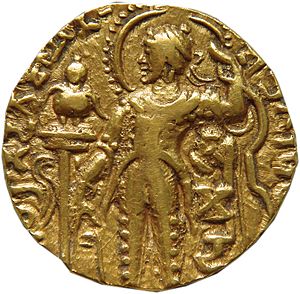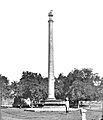Samudragupta facts for kids
Quick facts for kids Samudragupta |
|
|---|---|
| Maharajadhiraja | |

Coin of Samudragupta, with Garuda pillar, emblem of Gupta Empire. The name
|
|
| Gupta Emperor | |
| Reign | c.335-375 CE |
| Predecessor | Chandragupta I, possibly Kacha |
| Successor | Chandragupta II, or possibly Ramagupta Pataliputra |
| Spouse | Dattadevi |
| Issue | Chandragupta II, and possibly Ramagupta |
| House | Gupta dynasty |
| Father | Chandragupta I |
| Mother | Kumaradevi |
Samudragupta (Gupta script: ![]()
![]()
![]()
![]()
![]() Sa-mu-dra-gu-pta, r. c. (350-375 CE) was a ruler of the Gupta Empire of Ancient India. As a son of the Gupta emperor Chandragupta I and the Lichchhavi princess Kumaradevi, he greatly expanded his dynasty's political power.
Sa-mu-dra-gu-pta, r. c. (350-375 CE) was a ruler of the Gupta Empire of Ancient India. As a son of the Gupta emperor Chandragupta I and the Lichchhavi princess Kumaradevi, he greatly expanded his dynasty's political power.
The Allahabad Pillar inscription, a prashasti (eulogy) composed by his courtier Harishena, credits him with extensive military conquests. It suggests that he defeated several kings of northern India, and annexed their territories to his empire. He also marched along the south-eastern coast of India, advancing as far as the Pallava kingdom. In addition, he subjugated several frontier kingdoms and tribal oligarchies. His empire extended from Ravi River in the west to the Brahmaputra River in the east, and from the Himalayan foothills in the north to central India in the south-west; several rulers along the south-eastern coast were his tributaries.
Samudragupta performed the Ashvamedha sacrifice to prove his imperial sovereignty, and according to his coins, remained undefeated. His gold coins and inscriptions suggest that he was an accomplished poet, and also played music. His expansionist policy was continued by his son Chandragupta II.
Images for kids
-
Text of the Allahabad stone pillar inscription of Samudragupta, in the Brahmi script.
-
A gold coin of Samudragupta
-
Commemorative type of Chandragupta I: this coin is in the name of Chandragupta I, but since no other coin types of Chandragupta are known, this is thought to be a commemorative issue minted by his son Samudragupta.
See also
 In Spanish: Samudragupta para niños
In Spanish: Samudragupta para niños







